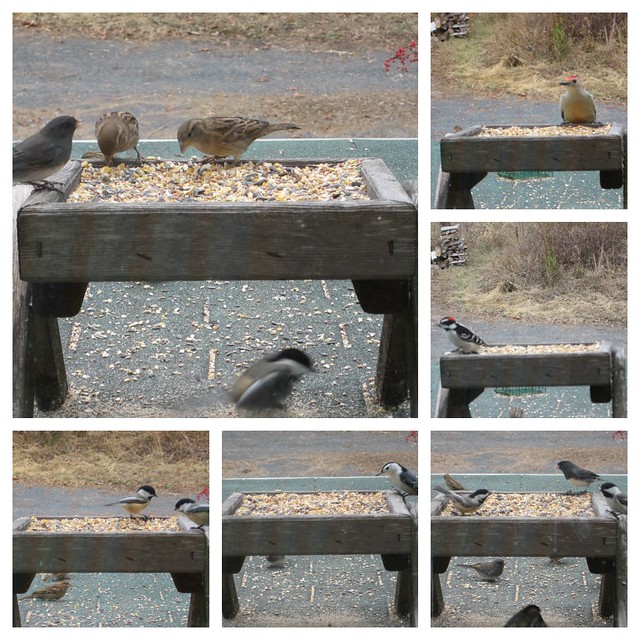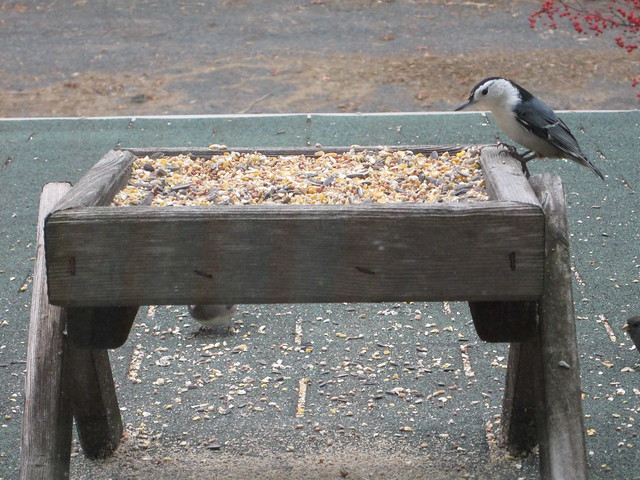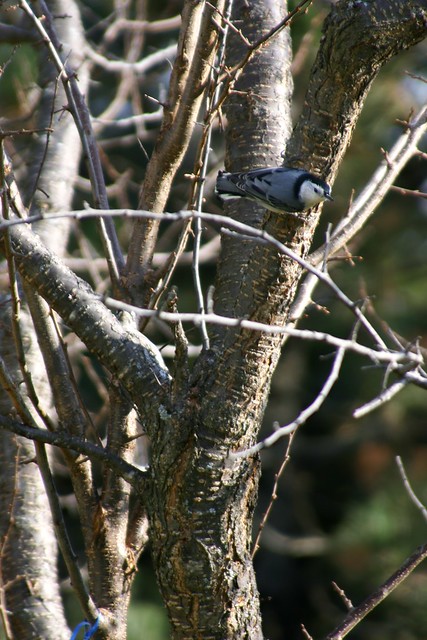=> Nuthatches and black-capped chickadees both have black feathers on the top of their heads, but the nuthatches do not have a black bib like the chickadees do.
Variety of birds at the feeder including
a nuthatch and black-capped chickadees.
Taken on March 13, 2013.
=> Nuthatches and chickadees hunt together all winter. Chickadees hunt over the twigs and smaller branches, while the nuthatches prefer tree trunks and the bases of the branches.
=> You often see this bird upside down. It holds itself safely in this position by thrusting its toes out at right angles to the body, thus getting a firm hold upon the bark.
=> The front toes are strong and the hid toe is very long. It is armed with a strong claw.
=> The bird runs about on the tree so rapidly that it has earned the name of "tree mouse."
=> The beak is long and slender, being as long as the head or longer.
A nuthatch figuring out which seed to take.
Taken on October 29, 2012.
=> The beak is fitted to reach in crevices of the bark and pull out hiding insects or to hammer open the shell of nut or acorn and get both the meat of the nut and the grub feeding upon it.
=> After eating suet, it will wipe its bill on a branch, first on one side and then the other, until it is perfectly clean.
=> Nuthatches are a great benefit to trees in winter because they hunt for hiding pests on the trunks.
=> Their food consists of beetles, caterpillars, pupae of various insects, and seeds of ragweed, sunflowers, and acorns.
=> During the winter this bird is commonly seen. During nesting season, they usually retire to the deep woods to occupy a cavity in a tree used by a woodpecker last year or make a hole for themselves.
=> The nest is lined with leaves, feathers, and hair.
=> A female nuthatch lays between five to nine creamy, speckled eggs.
Next, we read in the Handbook of Nature Study about the feet of birds on page 40-41.
“The feet of birds are shaped so as to assist the bird to
get its food as well as for locomotion.”
~ Handbook of Nature Study, page 41
This section compared a hen's feet with a duck's feet:
=> The hen is a digger of the soil so her claws are long, strong, and slightly hooked. They are covered with scales to protect her feet from injury when scratching in the hard earth.
=> The wings help a hen to move along more quickly when she runs.
=> Her strong toes help give her a firm foothold when she runs.
=> Her tracks look like three toe-marks projecting forward and one backward.
=> A duck has the same number of toes as the hen, but there is a membrane, called the web, which joins the second, third, and fourth toes.
=> The first or hind toe has a little web of its own.
=> The webbed feet are like a paddle for propelling in the water, and help the duck on land from sinking into the soft mud because of their breadth and flatness.
=> The duck's legs are shorter than those of the hen and are placed farther back and wider apart. They are essentially swimming organs and are not fit for scratching or running.
=> A duck on land waddles because the short legs are so far apart and so far back. Yet, in the water, the duck is a graceful bird.
=> The hind claw of a hen enables her to clasp a roost firmly during the night whereas a duck's foot could not do this.
Size and Shape
The largest nuthatch, this is still a small bird with a large head and almost no neck. The tail is very short, and the long, narrow bill is straight or slightly upturned.
Color Pattern
White-breasted nuthatches are gray-blue on the back, with a frosty white face and underparts. The black or gray cap and neck frame the face and make it look like this bird is wearing a hood. The lower belly and under the tail are often chestnut.
Behavior
White-breasted Nuthatches are agile birds that creep along trunks and large branches, probing into bark furrows with their straight, pointed bills. Like other nuthatches, they often turn sideways and upside down on vertical surfaces as they forage. They don’t lean against their tails the way woodpeckers do.
A nuthatch in the plum tree.
Taken on November 11, 2007.
Habitat
White-breasted nuthatches are birds of mature woods and woodland edges. They’re particularly associated with deciduous stands, including maple, hickory, basswood, and oak, though they can be found in some coniferous forests.
Food
White-breasted nuthatches eat mainly insects, including weevil larvae, wood-boring beetle larvae, other beetles, tree hoppers, scale insects, ants, gall fly larvae, caterpillars (including gypsy moths and tent caterpillars), stinkbugs, and click beetles, as well as spiders. They also eat seeds and nuts, including acorns, hawthorn, sunflower seeds, and sometimes crops such as corn. At birdfeeders they eat sunflower seeds, peanuts, suet, and peanut butter.
A nuthatch at the feeder.
Taken on February 22, 2011.
Nuthatch Songs
We listened to what nuthatches sound like by listening to a recording of nuthatch songs on All About Birds.
Facts
The White-breasted Nuthatch is normally territorial throughout the year, with pairs staying together. The male has to spend more time looking out for predators when he’s alone than while he’s with his mate.
In winter, white-breasted nuthatches join foraging flocks led by chickadees, perhaps partly because it makes food easier to find and partly because more birds can keep an eye out for predators.
White-breasted nuthatches who are making lots of quick trips to and from a feeder – too many for it to be eating them all – may be storing the seeds for later in the winter, by wedging them into furrows in the bark of nearby trees.
Nature Journal Entries
Both Sophia and Olivia did a entry in their nature journals about nuthatches. This is Sophia's nature journal entry:
This is Olivia's nature journal entry:
(We used Outdoor Hour Challenge: Birds - Woodpecker, Chickadee, Nuthatch, and Towhee as inspiration and a starting point for our nature study.)







1 comment:
I loved watching nuthatches and chickadees hunt together when we lived in Colorado.
Post a Comment